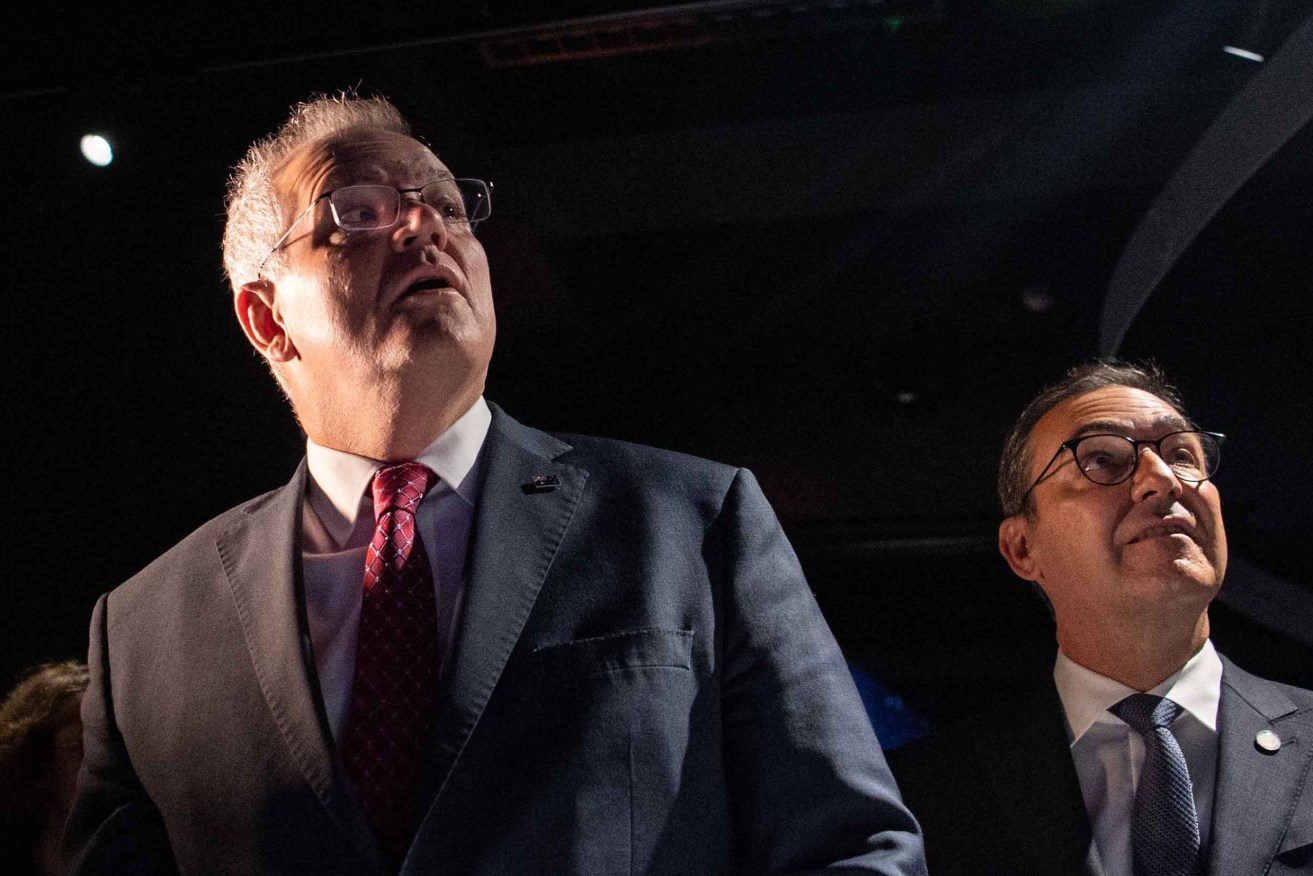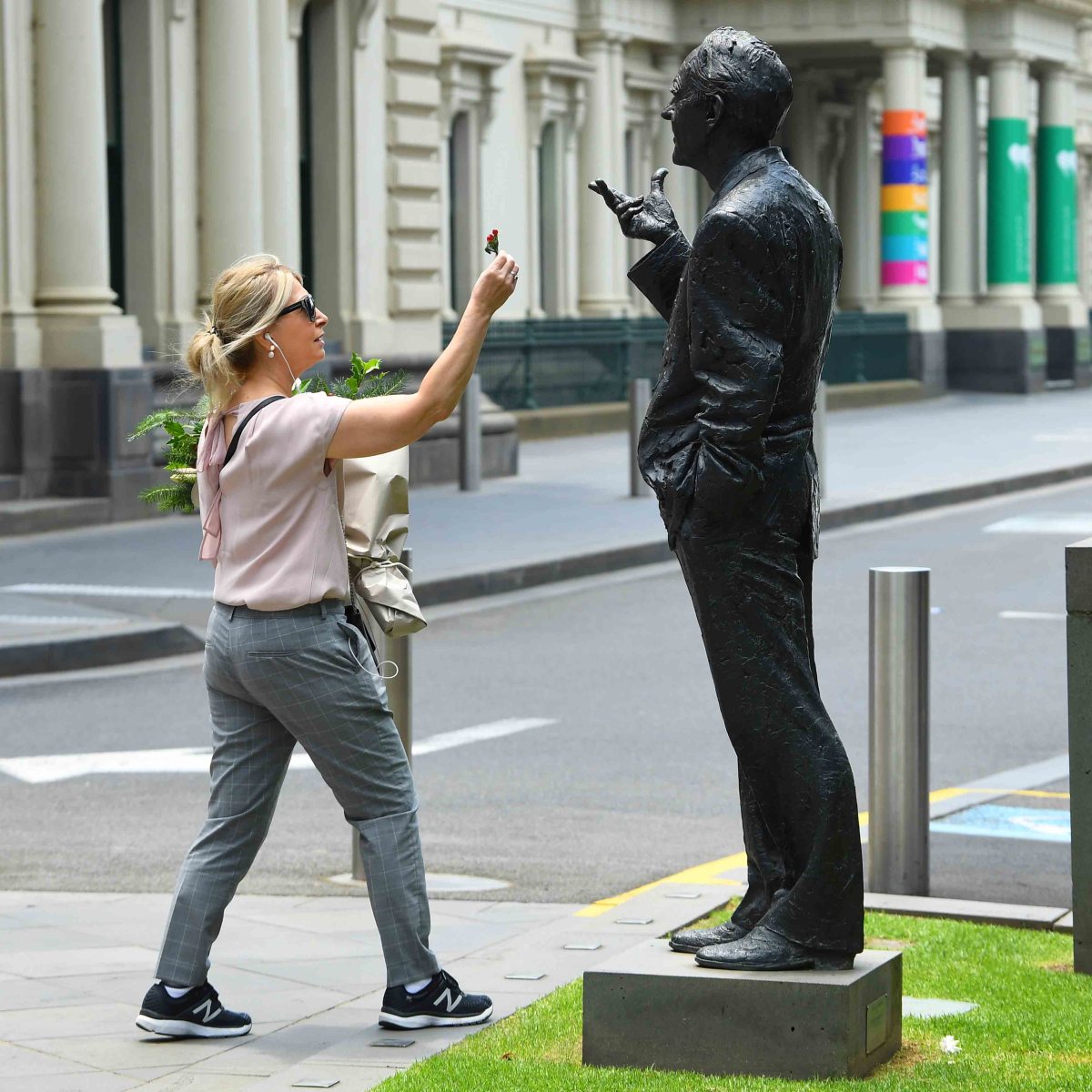Is it time for the Liberals to end the party? It couldn’t hurt
The way elections are won in Australia has changed and the Liberal Party is struggling to adapt. Matthew Abraham argues the party needs a radical rethink.


Peering into the future... Scott Morrison and Steven Marshall at Adelaide's Australian Space Discovery Centre in 2021. Photo: AAP/Morgan Sette
While the rest of the civilised world is busy tearing down statues, Adelaide needs to turn its mind to whipping up a special batch of new ones.
What’s not to like about a person immortalised in bronze? One of the highlights of our family’s time living in Louisville, Kentucky, way back in 1985, was chancing upon the statue of Daniel Boone, complete with his trademark racoon skin hat, on the outskirts of the city’s Cherokee Park.
After his stunning election victory on the weekend, Victorian Premier Dan Andrews is now on track to become a bronze statue.
In about three months, the man known as Chairman Dan will notch up 3000 days in office. This makes him eligible to be cast in bronze under a scheme dreamt up by former Liberal Premier Jeff Kennett in 1999.
The Australian’s Victorian editor, Damon Johnston, explains that on February 17 next year, Andrews will qualify to join the statues of Albert Dunstan (3834 days, 1935-45), Henry Bolte (6288 days, 1955-72), Rupert Hamer (3209 days, 1972-81) and John Cain Jr (3047 days, 1982-90).
Kennett was “closing in on being the fifth statue but Victorians voted him out after 2571 days in office”, Johnston explains. Tough bickies, Jeff.
The 3000-day statues honouring long-serving premiers is a terrific idea and one we should shamelessly steal from the people of Danistan. After all, they stole our Grand Prix, didn’t they?
While the Vic statues stand outside their Premier’s Office, ours should be bolted down with the bronze pigs in the Mall – Horatio, Oliver, Truffles and Augusta.
These statues would say a lot about where we’ve been as a state and the changing voting patterns at play not just in South Australia, but right across Australia.

A woman places a flower onto the statue of former Victorian Premier John Cain in Melbourne’s Treasury Place. Photo: AAP/ James Ross
While the Victorian statues are mainly blue, ours would be a sea of red.
Three of the four Victorian statues were conservative Premiers – Bolte, Dunstan and Hamer – with Cain the only Labor man in bronze. The reverse would apply in SA.
We also have four Premiers who have clocked the magic 3000 days on the political odometer – Sir Thomas Playford (9623 days, 1938-65), Don Dunstan (3502 days, 1967-68 and 1970-79), John Bannon (3587 days, 1982-92) and Mike Rann (3518 days, 2002-11).
With the outstanding exception of Playford, who led the Liberal and Country League, the precursor to today’s Liberal Party, Dunstan, Bannon and Rann were all Labor Premiers.
Never say never, but as it stands today it’s difficult to see another Liberal premier earning a 3000-day statue in our state. Or in Victoria. Or anywhere else if we’re going to be cruel.
The three elections this year – SA’s March election, the May federal election and last weekend’s Victorian election – have all confirmed a seismic change in our nation’s traditional voting patterns.
In each election, the primary vote for the winning party was either low or went backwards, majority government was won or enhanced on the back of Greens preferences, and independent candidates emerged as a significant threat to both major parties.
The consistent pattern is that the Liberal brand is in big trouble. It’s been in trouble for a while now, but the question needs to be asked – is it so bad, it may be terminal?
It was once an iron rule of Australian politics that to win an election, your primary vote needed a four in front of it. Without a primary vote of more than 40 per cent, you couldn’t win. That no longer applies.
The ALP now wins consistently with a three in front of its primary vote.
Anthony Albanese defeated Scott Morrison’s Liberals with Labor’s primary vote on 35.6 per cent and Peter Malinauskas won here with a 39.97 per cent primary.
Daniel Andrews has won with 37.2 per cent of the “popular” vote – a big swing against Labor of almost 6 per cent. But with Greens and other preferences, that converts into a two-party preferred estimate of 54.2 per cent for the Andrews Government, on the latest ABC calculations.
The Liberals led by Matthew Guy ran hard against Premier Andrews, while mimicking his big-spending policies. It was all about Dan.
As one Twitter wag observed: “all of the Labor party voting material had pictures of Dan Andrews on it and all of the Liberal party voting material had pictures of Dan Andrews on it and maybe people just thought Dan Andrews was the only guy there was”. That’s not as dumb as it sounds.
It took just 24 hours after election night for a familiar refrain to emerge – the Liberals either must “reconnect” with metropolitan voters, particularly millennials, or “reconnect” with something called “traditional values”, whatever they are.
Alan Tudge, the member for the federal Melbourne seat of Aston, said the party lost its way during the COVID pandemic.
“Throughout the pandemic, we had to compromise traditional values and we need to go all the way back to those values and re-energise them – personal responsibility, sound financial management, home ownership and high education standards,” he said.
After every devastating Liberal loss, the party says it needs to reconnect either with modern values or traditional values. It sounds like a party that doesn’t know what it is anymore.
What has the Liberal Party got to lose, apart from losing?
The Marshall Government pursued a city-centric Greens agenda – including embracing state-sponsored voluntary euthanasia, legalising full-term abortions and action on climate change.
Yet it got walloped in the city and failed to win back seats held by renegade, conservative independents in the bush. I don’t buy the theory that the Marshall Government was ousted after just one term because it merely bungled the transition out of the pandemic lockdowns. Something bigger is at play.
In Victoria, the only conservative winners were the Nationals, outperforming both the Greens and their Liberal cousins by picking up four seats to give them a healthy nine in the 88-seat lower house.
Rather than perpetually mumbling about “reconnecting”, the party might have to cash in its chips, disband and emerge from the ashes as a new party, or a collection of minor parties and independents able to work together to form government. It happens all the time in Europe and they seem to manage.
In 1972, former Liberal Premier Steele Hall formed an internal ginger group within Playford’s creaking, fusty LCL in a bid to force a more modern policy agenda.
It became the breakaway Liberal Movement between 1973 and 1976, a short-lived party but one that shook the joint up no end. It not only generated SA’s modern Liberal Party, but also gave birth to the Australian Democrats, the original “Teals” decades before the word had been invented.
What has the Liberal Party got to lose, apart from losing?
Just like statues, political parties that stand still end up getting pooped on from a great height.
Matthew Abraham’s weekly analysis of local politics is published on Fridays.
Matthew can be found on Twitter as @kevcorduroy. It’s a long story.




